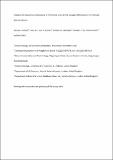Files in this item
Interplay of robustness and plasticity of life-history traits drives ecotypic differentiation in thermally distinct habitats
Item metadata
| dc.contributor.author | Liefting, M. | |
| dc.contributor.author | van Grunsven, R.H.A. | |
| dc.contributor.author | Morrissey, M.B. | |
| dc.contributor.author | Timmermans, M.J.T.N. | |
| dc.contributor.author | Ellers, J. | |
| dc.date.accessioned | 2016-04-18T09:44:19Z | |
| dc.date.available | 2016-04-18T09:44:19Z | |
| dc.date.issued | 2015-05 | |
| dc.identifier | 190338697 | |
| dc.identifier | 8a5af3a3-9e95-4913-bb67-5eb2e8749f66 | |
| dc.identifier | 84929705987 | |
| dc.identifier | 000355012700007 | |
| dc.identifier.citation | Liefting , M , van Grunsven , R H A , Morrissey , M B , Timmermans , M J T N & Ellers , J 2015 , ' Interplay of robustness and plasticity of life-history traits drives ecotypic differentiation in thermally distinct habitats ' , Journal of Evolutionary Biology , vol. 28 , no. 5 , pp. 1057-1066 . https://doi.org/10.1111/jeb.12629 | en |
| dc.identifier.issn | 1010-061X | |
| dc.identifier.uri | https://hdl.handle.net/10023/8622 | |
| dc.description | JE and ML were supported by the Netherlands Organisation for Scientific Research, VIDI Grant No. 864.03.003 and VICI Grant No. 865.12.003. MBM was supported by a University Research Fellowship from the Royal Society (London). Date of Acceptance: 23/03/2015 | en |
| dc.description.abstract | Phenotypic plasticity describes the ability of an individual to alter its phenotype in response to the environment and is potentially adaptive when dealing with environmental variation. However, robustness in the face of a changing environment may often be beneficial for traits that are tightly linked to fitness. We hypothesized that robustness of some traits may depend on specific patterns of plasticity within and among other traits. We used a reaction norm approach to study robustness and phenotypic plasticity of three life-history traits of the collembolan Orchesella cincta in environments with different thermal regimes. We measured adult mass, age at maturity and growth rate of males and females from heath and forest habitats at two temperatures (12 and 22 °C). We found evidence for ecotype-specific robustness of female adult mass to temperature, with a higher level of robustness in the heath ecotype. This robustness is facilitated by plastic adjustments of growth rate and age at maturity. Furthermore, female fecundity is strongly influenced by female adult mass, explaining the importance of realizing a high mass across temperatures for females. These findings indicate that different predicted outcomes of life-history theory can be combined within one species' ontogeny and that models describing life-history strategies should not assume that traits like growth rate are maximized under all conditions. On a methodological note, we report a systematic inflation of variation when standard deviations and correlation coefficients are calculated from family means as opposed to individual data within a family structure. | |
| dc.format.extent | 1869121 | |
| dc.language.iso | eng | |
| dc.relation.ispartof | Journal of Evolutionary Biology | en |
| dc.subject | Ecotype-specific | en |
| dc.subject | Inflation of variance | en |
| dc.subject | Life-history theory | en |
| dc.subject | Orchesella cincta | en |
| dc.subject | Phenotypic plasticity | en |
| dc.subject | Random regression mixed model | en |
| dc.subject | Reaction norm | en |
| dc.subject | Temperature | en |
| dc.subject | QH301 Biology | en |
| dc.subject | DAS | en |
| dc.subject.lcc | QH301 | en |
| dc.title | Interplay of robustness and plasticity of life-history traits drives ecotypic differentiation in thermally distinct habitats | en |
| dc.type | Journal article | en |
| dc.contributor.institution | University of St Andrews. School of Biology | en |
| dc.contributor.institution | University of St Andrews. Centre for Biological Diversity | en |
| dc.identifier.doi | https://doi.org/10.1111/jeb.12629 | |
| dc.description.status | Peer reviewed | en |
| dc.date.embargoedUntil | 2016-04-16 | |
| dc.identifier.url | http://onlinelibrary.wiley.com/doi/10.1111/jeb.12629/suppinfo | en |
This item appears in the following Collection(s)
Items in the St Andrews Research Repository are protected by copyright, with all rights reserved, unless otherwise indicated.

